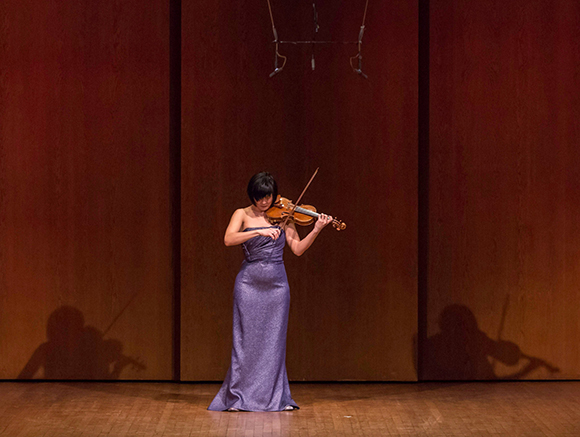The New York Times
By David Allen
February 1, 2015
original
link
A Bach Interpretation Springs to Life
Jennifer Koh’s Bach and Beyond Part III for Violin

Jennifer Koh's Bach and Beyond Part III at the 92nd Street Y included John Harbison’s “For Violin Alone.”
Credit Emon Hassan for The New York Times
John Harbison’s new work for Jennifer Koh is “For Violin Alone.” It’s a simple title, but one that evokes the essential solitude that draws listeners and violinists to Bach’s solo works for violin. There’s a unique rawness to watching the sonatas and partitas played live, more so even than the cello suites. The hush is audible, the imagery statuesque.
The statue came in triplicate on Saturday night, as Ms. Koh completed her indispensable Bach and Beyond series at the 92nd Street Y. It was probably accidental, but as she stood, erect and square in Bach’s Sonatas in A minor and C major, two equidistant shadows swayed on the back wall of the stage. That quirk of lighting could stand as a metaphor for her four-year project: Bach surrounded by composers from Bela Bartok to Kaija Saariaho and Esa-Pekka Salonen, all in his penumbra, the past and present combining in the harmony of performance, connected but independent.
Ms. Koh called the relationship “communion” in her program note, one of “circularity and symmetry.” That was clear in Luciano Berio’s “Sequenza VIII,” which owes much to the chaconne that ends Bach’s Partita in D minor. The Berio work obsesses over a clash between two notes, A and B, harping savagely on the dissonance and exploring it in smooth passages and caustic, brittle interruptions. Here, with bow hairs flying everywhere, Ms. Koh was at her most ruthlessly committed and distinct.
More of the attention to detail heard in the Berio was needed for the world premiere of Mr. Harbison’s intriguing piece. “For Violin Alone” is also based on Bach’s forms, this time a complete partita. It toys with arcane ideas across seven movements, and with a summarizing “Epilogue” it’s more unified than any of Bach’s suites. Neither the “Dance 1” nor “Dance 2” movements really dance, but the “March” powerfully contrasts strident, brash passages (marked “con bravura”), with fearful, quiet flickers (“timido, ansioso”). “Air” sings restlessly, and there’s a bluegrass feel to the opening set of variations, “Ground.” With time, Ms. Koh will probably find more in a work that, like much of Mr. Harbison’s recent writing, has much to give.
Bach, of course, never stops giving. Violinists influenced by Baroque practice like Isabelle Faust and Alina Ibragimova find more crispness in their Bach than Ms. Koh. But Ms. Koh has an allusive breadth of sound — a voice’s quiver, an organ’s force — and stirred an intensity so strong in two mammoth fugues that my ears filled in the harmonies left implicit by the limits of a violin’s four strings. Both sonatas were weighty and steeped in tragedy at times, but never leaden in sprightlier moments. I’d call them monumental, if they hadn’t been so alive.
Jennifer Koh performs Bach and Beyond Part III on Friday at the University of Michigan’s Rackham Auditorium, 915 East Washington Street, Ann Arbor; ums.org.
A version of this review appears in print on February 2, 2015, on page C3 of the New York edition with the headline: A Bach Interpretation Springs to Life.
Copyright ©2015 The New York Times
© Jennifer Koh, All Rights Reserved. Photography by Juergen Frank. Site by ycArt design studio